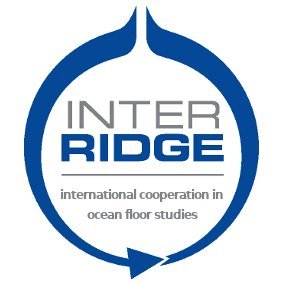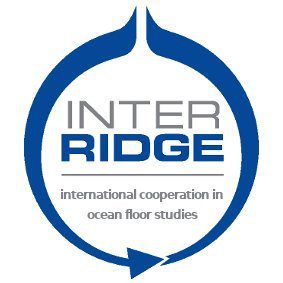InterRidge Fellows 2008
As part of our mission to promote international, collaborative, and interdisciplinary studies of oceanic spreading centers, and to reach out the next generation of ridge-crest scientists, we initiated the InterRidge Student Fellowship Program in 2008 with a call for two fellowships of up to $3000 US each. These fellowships can be used for any field of ridge-crest science. In particular these awards are encouraged to be used for international cruise participation, international laboratory use, and adding an international dimension to a student’s thesis work. The InterRidge Student and Postdoctoral Fellowship Program continues to play an important role in the careers of early career ocean scientists.
The recipients of this year’s InterRidge Fellowships is:
Michelle Harris (a PhD candidate at National Oceanography Centre (NOC), UK)
Kerry Howard (a PhD candidate at Cardiff University, UK)
Michelle Harris (a PhD candidate at National Oceanography Centre (NOC), University of Southampton, UK)
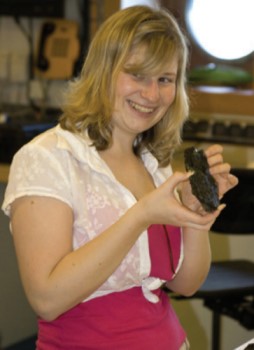
The title of Harris’s project is “An oxygen isotope investigation of an intact section of upper ocean crust.” Harris will analyze samples obtained at ODP/IODP Hole 1256D on the flank of the East Pacific Rise. These data will supplement existing whole rock oxygen data and be combined with strontium isotope data from the same samples to quantify fluid flow in the Site 1256 upper crust. Harris is advised by Prof. Damon Teagle and Dr. Tim Henstock at NOC, and the fellowship will be conducted with Dr. Neil Banerjee at University of Western Ontario, Canada.
Harris received an undergraduate degree in Geology at University of Leeds, UK. As part of her degree, she studied at the University of California Santa Barbara (UCSB), and Harris writes, “It was during my time at UCSB that I became interested in marine geology and hydrothermal systems and on my return to Leeds worked on some gabbro samples from IODP Hole 1309B with Dr. A. McCaig for my Masters project.”
She decided to apply for a PhD program because of her strong interest in mid-ocean ridges and their hydrothermal systems. Her thesis is investigating the role of hydrothermal fluids during the accretion of fast spread ocean crust using isotopes as tracers of fluids and diffusion modeling to determine cooling rates for samples from IODP Hole 1256D and also from Hess Deep. She will integrate these results into thermal models of crustal accretion to test potential geometries of crustal accretion.
Michelle’s Report from her staying at University of Western Ontario, Canada
I visited the University of Western Ontario, Canada, in June-July 2009 to undertake the stable isotope analyses proposed in my InterRidge student fellowship project, “An oxygen isotope investigation of an intact section of upper oceanic crust.” This project is in collaboration with Prof. Neil Banerjee. The project aimed to investigate the conditions of hydrothermal circulation at Oceanic Drilling Program (ODP) Hole 1256D by investigating new oxygen isotope data with my existing strontium isotope study and petrological observations of hydrothermal alteration for my Ph.D project supervised by Prof. Damon Teagle.
During my visit I was trained at the Laboratory for Stable Isotope Science to use the silicate line to produce oxygen isotope data. The procedure involves initially extracting the oxygen from the silicate samples by reaction with CIF 3 at high temperatures, and then converting the oxygen to CO 2 to be measured on the mass spectrometer. This process allows the oxygen isotope ratio of the sample to be determined. I analysed a selection of whole rock samples and mineral separates from ODP Hole 1256D, focussing on samples from the sheeted dike and plutonic complexes. This included detailed sampling across dike margins to investigate the role of focussed fluid flow in the hydrothermal system, and quartz-epidote mineral separates to estimate the temperatures of the fluids.
Fully understanding hydrothermal processes in oceanic crust is important for testing crustal accretion processes and quantifying hydrothermal inputs to global geochemical cycles. The oxygen isotope results from mineral separates collected during my visit have provided key constraints on the temperature of hydrothermal fluids in the lower sheeted dikes and plutonic rocks in ODP Hole 1256D. This is particularly important as the samples come from the first intact sampling of the dike-gabbro boundary, and understanding these processes from in situ samples is critical. Thee new results demonstrate that high temperature fluids circulated through the sheeted dike complex and down into the plutonic complex and, that significant focussing of the fluids has occurred along dike margins and intrusive contacts in the plutonic complex. The combination of the new oxygen isotopes with my existing strontium isotpes will allow me to further constrain the magnitude of the fluid flux through Site 1256.
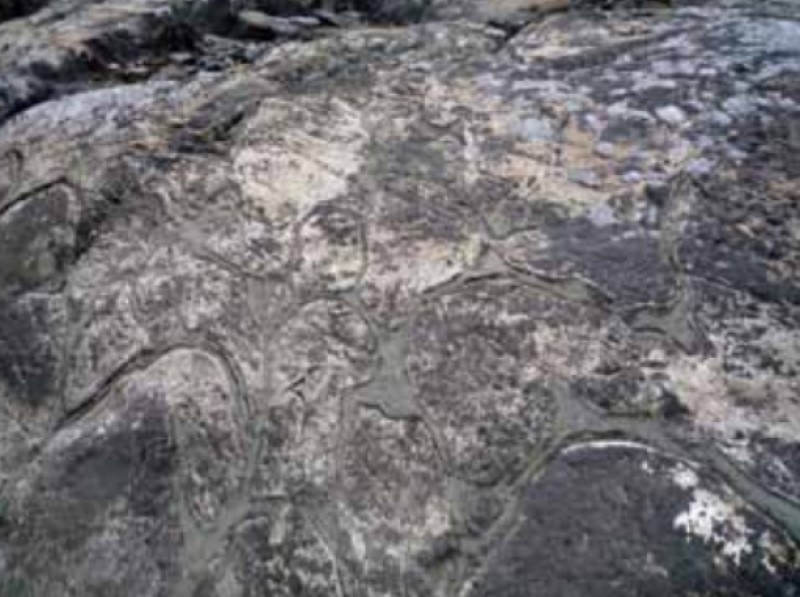
Figure 1: Pillow lavas exposed at the Abitibi Greenstone Belt in northern Canada.
I was also fortunate to spend a short, but very interesting time in the field with Prof. Banerjee and his research students looking at hydrothermal systems in Archean rocks form the Abitibi Greenstone Belt in northern Canada (Fig. 1). My visit was a very productive and enjoyable experience, and I would like to thank Prof. Banerjee for hosting me, and in particular Kim Law in the Stable Isotope Lab at the University of Western Ontario for accommodating my project and introducing me to stable isotope geochemistry. In addition, I would like to thank InterRidge for providing this unique opportunity for me to develope my career in mid-ocean ridge science.
Kerry Howard (a PhD candidate at Cardiff University, UK)
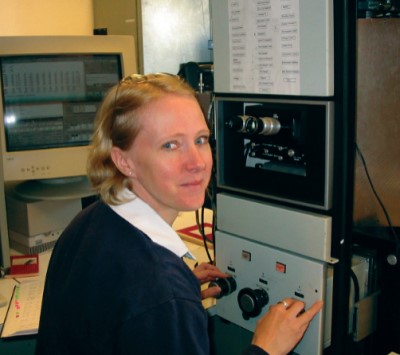
The title of Howard’s proposal is “Accretion of fast-spreading lower ocean crust at Hess Deep.” On the walls of the Hess Deep rift valley, a section of crust from the East Pacific Rise is exposed. Howard will conduct petrographic analyses, including election backscatter diffraction measurements of crystal lattice-preferred orientations, for samples obtained with ROV Isis in 2008. Howard is advised by Dr. Chris MacLeod and Prof. Julian Pearce at Cardiff University, and the fellowship will be conducted with Dr. Benoit Ilefonse at University Montpellier II, France.
Howard writes, “I developed an interest in geoscience somewhat later in life than many, but was so intrigued by it that I abandoned my ‘normal’ life to become an undergraduate at Leicester University.”
She developed an interest in igneous petrogenesis and geochemistry, and after receiving her undergraduate degree worked as research assistant to Dr. Laurence Coogan (University of Victoria, Canada), analyzing samples from the Oman ophiolite in order to investigate focused fluid flow at fast-spread mid-ocean ridges. After a short break from geology, she commenced a PhD studentship at Cardiff University, investigating lower crustal accretion mechanisms at fast-spread mid-ocean ridges. Regarding her samples from the RRS James Cook JC21 research cruise to Hess Deep, Howard continues, “I am now looking forward to analyzing these samples in a variety of ways, including the use of EBSD that has been made possibly by this award. My current interests are mid-ocean ridges and ophiolites, and how insight into magmatic processes can be gained by combining fabric analyses with geochemistry”.
Kerry’s Report from her staying at University of Western Ontario, Canada
Hess Deep in the eastern Pacific Ocean is a rift valley formed by the westward propagation of the Cocos-Nazca spreading centre into the Galapagos microplate. At this unique location a complete, albeit dismembered, section of oceanic crust that formed ~1 Myr ago at the East Pacific Rise (EPR) is exposed in the valley walls and floor. The purpose of research cruise JC21 aboard the RRS James Cook in 2008 (PI Chris MacLeod, Cardiff University) was to obtain site survey information in support of proposed IODP drilling into the lower crustal section in Hess Deep. Using the UK’s Isis ROV, high-resolution bathymetry and seabed video was acquired from the proposed drill sites. In addition, samples were collected from all levels of the ocean crust and uppermost mantle, though concentrating on the plutonic section. Since the focus of my Ph.D project is the mechanism(s) by which the lower crust accretes at fast spreading ridges, my principal interest is in the geochemistry and petrofabrics of the 76 lower crustal gabbroic samples we collected with Isis. The aim is to use my results to test current accretion models and provide new constraints on the mechanisms involved in the formation of lower oceanic crust.
Being awarded an InterRidge Fellowship has enabled me to greatly expand the scope of my project by giving me the opportunity to conduct a systematic study of stratigraphic changes in crystallographic fabrics through the EPR lower crust using election backscatter diffraction (EBSD) analysis. This is a fast and accurate method for quantifying lattice preferred orientation (LPOs) of crystals in a sample. At Hess Deep these LPOs have been imparted by magmatic flow in the magma chamber beneath the EPR. EBSD utilises the omnidirectional scattering of electrons that results when a narrow SEM electron beam is focused onto the surface of a sample oriented at 70º to the incident beam. The diffraction of the electrons by the lattice planes in a crystal produces a spatial pattern, called a “Kikuchi” pattern, which consistents of a series of bands that vary with phase and crystal orientation. Comparison of these bands with a library of calculated patterns enables identification of both the mineral and its orientation. Further processing can provide phase maps of the sample and pole figures highlighting the orientations of specific crystallographic features.
My Fellowship allowed me to conduct this study by funding two trips to University Montpellier II, where, in collaboration with Dr. Benoit Ildefonse, I analysed 34 of the lower crustal samples from Hess Deep. My first visit to Montpellier, in August 2008, enabled me to familiarise myself with the EBSD technique and provided me with insight into the data it produced and its applications. Dr. Ildefonse instructed me in the use of the EBSD-dedicated SEM at Montpellier, and in the processing steps and different software necessary to convert the raw analyses to usable output. This first batch of eight analyses provided a tantalising glimpse into the range of magmatic fabrics that were present in the samples, and allowed for various combinations of phase images to be produced. A further 26 samples were analysed during my second trip, early in 2009, and I also had the opportunity to meet several other key workers in the field of EBSD analysis, including Dr. David Mainprice, the author of the software used to produce the pole figures.
Preliminary macroscopic observations revealed a large range in intensity of magmatic fabrics, with rocks ranging from apparently undeformed to strongly foliated. This wide range of fabric strengths has been confirmed by the EBSD analyses, with foliations and lineations present to various degrees, either separately or in combination. This suggests that different crystallisation conditions occurred throughout the lower crust. By quantifying these fabrics in the context of their reconstructed stratigraphic positions, I will be able to determine changes of deformation and crystallisation conditions throughout the lower crust and hence test the accretion models.
As magmatic fabrics are generally defined by alignment of elongate tabular crystals, much of my early focus was on plagioclase grains, however I have recently begun investigating the fabrics exhibited by the clinopyroxene (cpx) grains. Comparison of the two sets of fabric data has shown that for most samples with strong fabrics there is a good correlation between the orientation of plagioclase and cpx foliations, but that such correlations are much less apparent in the samples with weak to moderate fabric intensities.
In addition to the study of plagioclase and cpx LPOs I am also carrying out a comparison of the silicate fabrics revealed by EBSD with magnetic fabrics identified by anisotropy of magnetic susceptibility (AMS) analysis. By doing this I hope to discover whether there is a correlation between the two, and to investigate the mineralogical and process-related reasons responsible for the results. Early findings show a clear relationship in some of the samples but not in all, so further study is required.
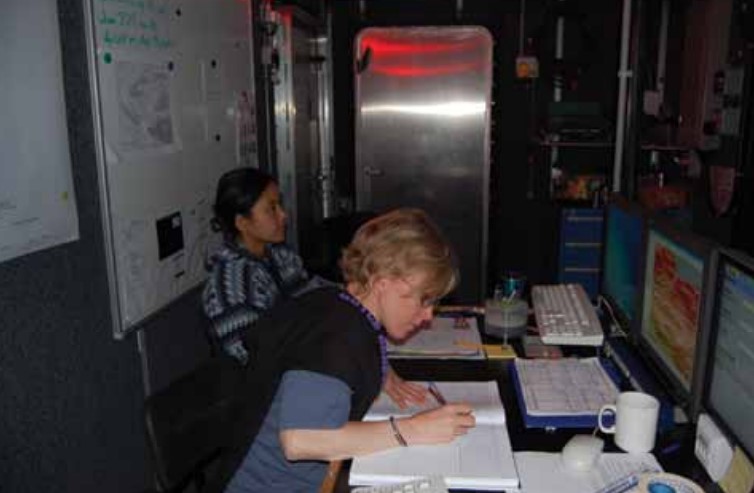
On watch in the Isis control room: Kerry Howard records events in the log while Masako Tominaga watches a sample being retrieved on the video display wall.
I am also shortly to conduct a pilot study in which I will compare the EBSD LPOs with shape-preferred orientations of grains. The latter I shall be acquiring via detailed image analysis of thin sections of a small sub-group of samples cut from orthogonal blocks oriented according to fabrics identified by the EBSD analysis. This should enable me to carry out an evaluation of the primary processes of cumulate formation within the lower crustal mush beneath a fast-spreading mid-ocean ridge.
I gratefully acknowledge the InterRidge Fellowship for giving me the opportunity to greatly extend the original goal of my Ph.D. project, for allowing me to learn new skills, and to forge strong links with key workers in an exciting field.
